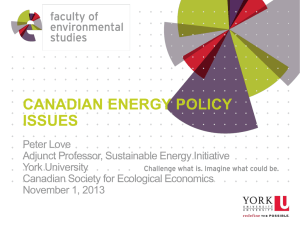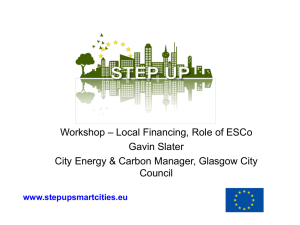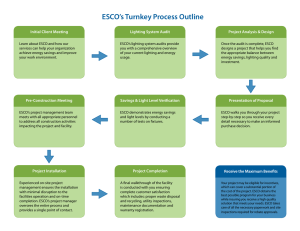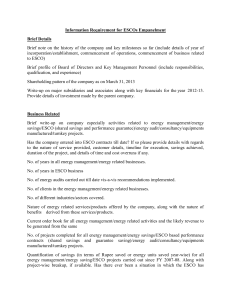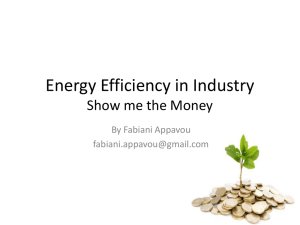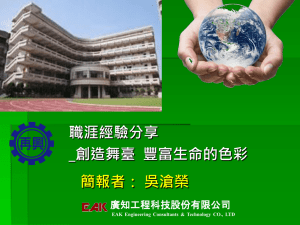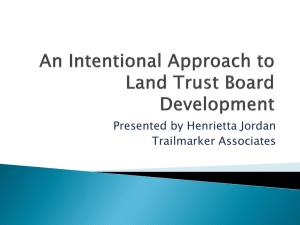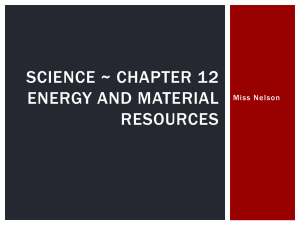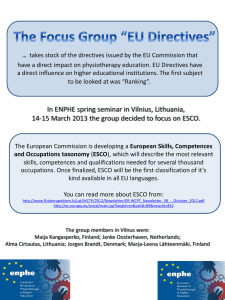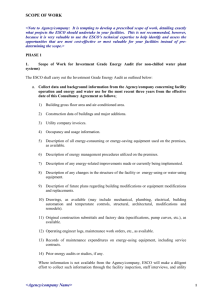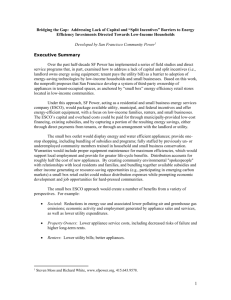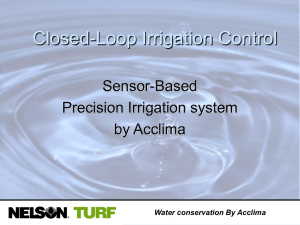Presentation Slides
advertisement
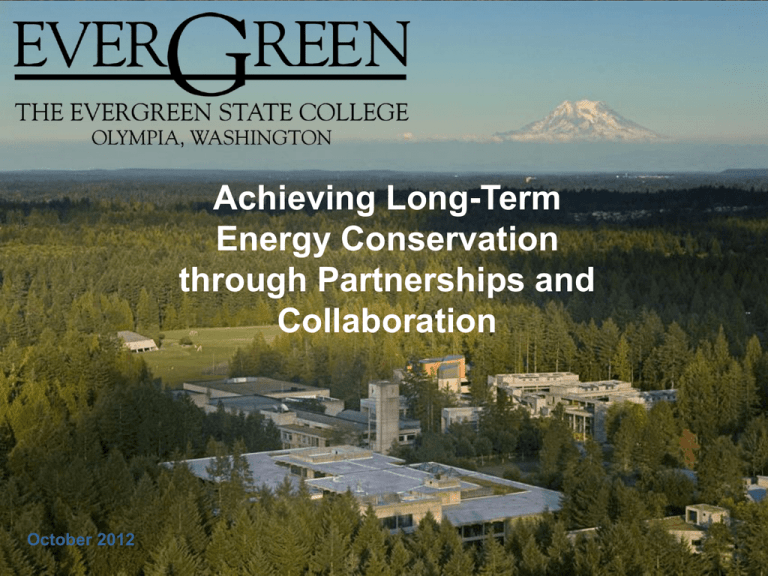
Achieving Long-Term Energy Conservation through Partnerships and Collaboration October 2012 • Presenters: – Paul Smith, Director, Facilities Services – Rich Davis, College Engineer – Mike Drennon, Manager, Plant Operations and Maintenance • Mission – “To sustain a vibrant academic community and to offer students an education that will help them excel in their intellectual, creative, professional and community service goals.” College Facts • • • • • Founded in 1967 Opened in 1971 Approximately 4500 students Olympia campus is 1000 acres 340 acres developed College Organization • No academic departments • Long history of sustainability interest • High student participation on social action issues • Strong bias towards consensus Strategic Planning Goals Education Supporting Financial Guiding Principles and Policies • Facilities Services – Evergreen: A Place for Sustainability – The college’s physical resources will imaginatively enhance the learning and working environment Guiding Principles and Policies • Critical Mandates – – Carbon Neutral by 2020 – Zero Waste by 2020 Offset Renew Conserve Areas of Implementation Budget ImplicationsUtility budget 35% of Operating Facilities Initiatives– – – – Conduct after hours light surveys Reduce steam pressure from 100 to 50 psi Add Resource Conservation Manager Look at building operating hours Areas of Implementation – Local Utility, Puget Sound Energy (PSE), Pilot Program to Shed Load (Demand Control) – ESCO based systemic upgrades – Change Operating Temperatures – 68˚-70˚ (winter) / 76˚-78˚ (summer) Reduced utility costs save $money$, jobs, environment! History May 2005 – Students vote for a student fee to provide “Green electricity” for the College 2007 – Work with State to get an Energy Service Company (ESCO) 2008 – Begin work on ESCO Phase 1 2008 – State budget crisis and recession surface 2009 – Complete ESCO Phase 1 2009 cont’d – • Receive grant for ESCO Phase 1 • Review operating procedures for central utility plant • Lower steam pressure from central utility plant • Begin discussions with Puget Sound Energy (PSE) on Resource Conservation Program (RCP) 2009 cont’d – • Develop RCP and apply for funding from PSE • Designate College Engineer as Resource Conservation Manager • Initiate RCP • Begin ESCO Phase 2 • Begin operational changes 2010 – • Begin campus wide campaign to reduce energy -lower/raise standard building temperature to 68/76 -send out all-college emails with energy conservation tips • Receive 2nd PSE grant 2010 cont’d – • Apply/receive grant from state Department of Commerce • Receive RCM grant from PSE 2011 – • Complete most of ESCO Phase 2 projects • Hire a part time temporary Resource Conservation Coordinator 2011 cont’d – • Commence library recommission • Continue all-campus email with energy conservation tips • Develop ESCO Phase 3 project scope 2012 – • Implement ESCO Phase 3 projects • Recruit/hire regular part time Resource Conservation Coordinator • Complete Library recommission Energy Savings Proposal – Phase 1 Projects Pool Cover & Heat Recovery 9KW Solar Photovoltaic Array Steam Trap Repair & Replacement Lab I Building Heat Recovery Energy Savings Proposal – Phase 1 Phase I: Total Cost $895,000 $75,000 $25,000 $370,000 $425,000 TESC Capital PSE Grant OFM Grant Clean Energy Grant Energy Savings Proposal – Phase 1 Energy Savings Guaranteed Annual Energy Savings Estimated Annual Reduction Measurement and Verification completed in 2010 4% of Evergreen’s 2005 baseline $72,786 709 metric tons of CO2 $97,111 964 metric tons of CO2 $72,786 guaranteed 709 metric tons of CO2 guaranteed Energy Savings Proposal – Phase 2 Projects Gym and Pavilion Lighting Upgrade Lab II Building Heat Recovery Swimming Pool Lighting Upgrade Library EMS Control System Upgrade and Optimization Energy Savings Proposal – Phase 2 Phase II: Total Cost $970,419 $300,000 $415,742 TESC Capital PSE Grant $254,677 DOC Grant Energy Savings Proposal – Phase 2 Energy Savings Guaranteed Annual Energy Savings Estimated Annual Reduction $80,900 915 metric tons of CO2 Partnerships Puget Sound Energy • • • • Energy grants and rebates Staff support for grants and rebates Resource Conservation Program Good communication of programs ESCO – McKinstry • Collaborated on grants and rebate requests • Willing to look at our energy conservation ideas • Partnered with college staff State Department of Commerce • Energy grant funding State Department of General Administration • Energy Services Contract Management • Allowed College to contract for energy projects and energy-related facility improvements College Staff, Faculty, Students • Accepted new temperature set points • Communicated with Facilities about energy conservation ideas • Self-monitored energy use • Senior Management accepted risk to achieve energy savings Collaboration • • • • Architects/ Engineers Contractors College Clean Energy Committee College Sustainability Council College Energy Use Electricity Cost Gas Cost 2009 16,395 mWh $1,313,000 117,613 mmBTU $1,024,000 2010 14,678 mWh $1,229,000 84,886 mmBTU $635,000 2011 13,937 mWh; $1,210,000 88,796 mmBTU $646,000 2012 13,851 mWh $1,194,000 88,585 mmBTU; $648,000 Ideas • • • • Review operating procedures Contact your utility Contact state energy office Contact US Department of Energy – Energy Efficiency and Renewable Energy Information Center (EEREInformationCenter@energy.wsu.edu) Ideas Cont’d • • • Inform college community of efforts and results Involve students – great energy and different ideas Encourage staff to be partners in energy conservation Ideas Cont’d • Look for energy waste - waste represents a potential project. • High energy use systems/high maintenance costs/poor function/low safety for staff create opportunities. Contact Information Paul Smith – smithpa@evergreen.edu 360-867-6115 Richard J. Davis, P.E. – davisr@evergreen.edu 360-867-6136 Mike Drennon – drennonm@evergreen.edu 360-867-6586 Questions?
